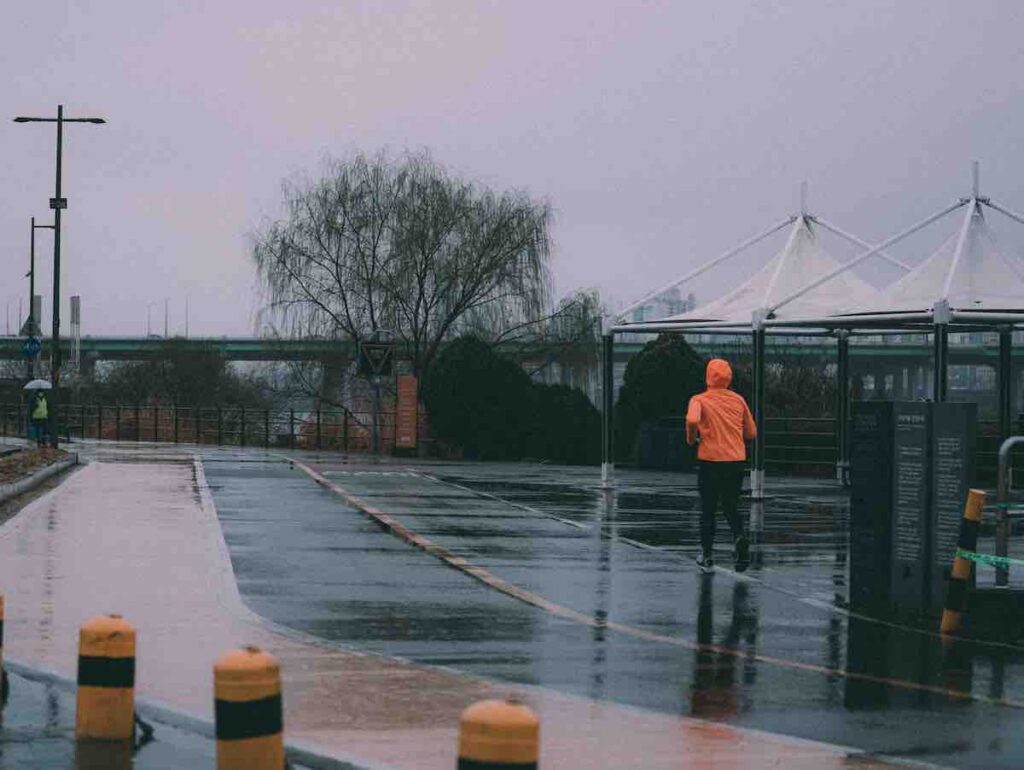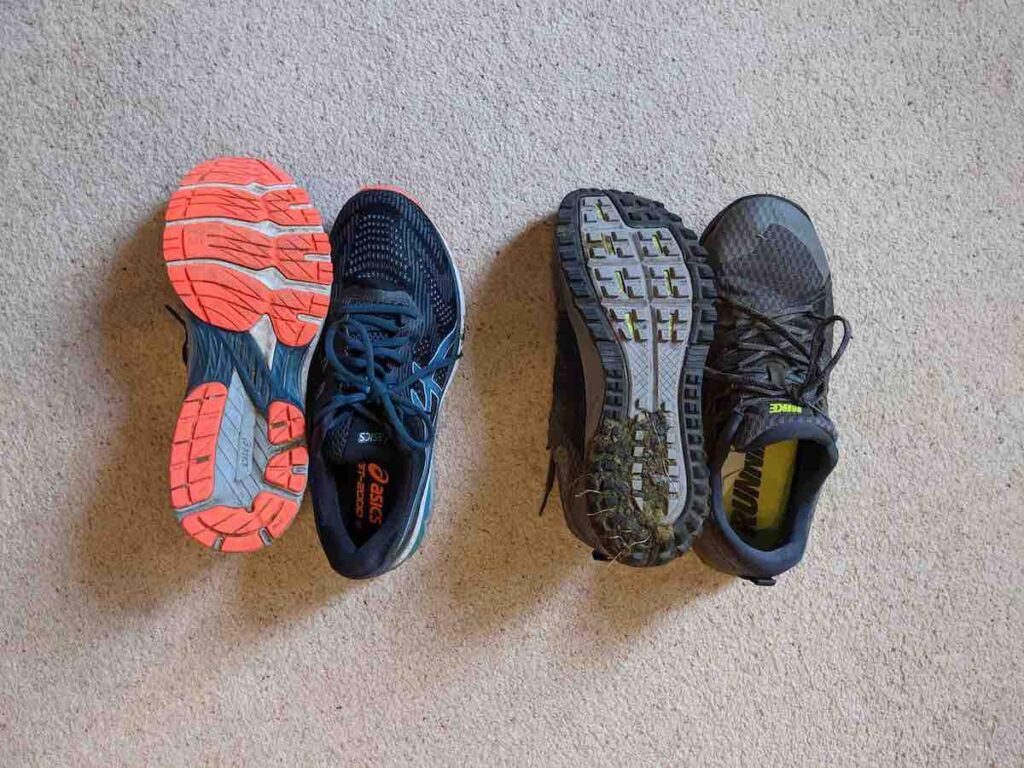Running in the rain gets a bad rap. Unfairly so in my opinion.
Full on rainy day runs or getting caught in an unexpected downpour can offer so much to a workout.
Refreshing. Cathartic. Even comforting. Life is too short for moderate pleasures!
Wet weather also provides a welcome change of running routine and brings extra challenges for race-ready athletes. Resilience is born in the rain.
As Autumn approaches, I wanted to share my positive experiences of running in the rain. How I went from a fair weather runner to embracing the extremes. Plus, how to meet the many obstacles wet runs throw at you head on, choosing the right gear, and preparing for every type of weather forecast.
If it’s raining, the answer is rarely to run on a treadmill.
10 Reasons Why I Love Running in the Rain
- The purest form of joy – there’s something childlike about playing in the rain
- Quieter streets – fair weather runners shun the rain, meaning paths are less crowded
- Wet runs are a great leveler – get an edge come race day by training in the rain
- The sweet smell of petrichor – the earthy scent produced when rain falls on dry soil
- Rainbows and gratitude – magic awaits you after and in-between wet runs
- Bundles of visual stimulation – layers of colors, textures and reflections
- Refreshingly cool – a welcome break from running in hot weather
- Cathartic and invigorating – wash away your problems and be re-energised
- No two rainy runs are alike – eventful, unexpected, even comical at times
- The rewards that await – the promise of a warm shower or hot chocolate after

Living in the UK, If I didn’t run in the rain, I’d have to avoid running for 6-9 months of the year. Not an option!
I’ve learned that the threat of rainfall is always far worse than the reality. Instead of running with one eye on the clouds or waiting to run in the sun, I now embrace showers. It’s this unpredictability that’s actually one of the main reasons why running makes me happy.
And if I achieve anything in this article, it’s to help you view rain as a vital nutrient for rich running adventures too.
The Science of Running in the Rain
As you head out for a run in wet conditions, several factors come into play, affecting your performance and experience.
Resistance Running
Firstly, headwinds and rain cause your body to face increased resistance. Tiny droplets consistently pelting against you, slowing you down slightly and requiring greater effort. While this effect may be subtle with rain, it becomes more significant over longer distances. Leaning into these challenges improves running stamina, power and running technique.
High Humidity
High humidity can make breathing more difficult, as the air feels heavy and moist. This sensation occurs because the air’s capacity to hold moisture decreases, causing water vapor to condense into liquid droplets. Despite the challenges, running in high humidity encourages your body to adapt over time, increasing your lung capacity and efficiency when breathing in less humid conditions.
Aids ‘Flow State’

Researchers from Harvard University and Kenan-Flagler Business School examined the effects of the weather on individual productivity in the workplace.
They found that bad weather increases individual productivity by eliminating potential cognitive distractions resulting from good weather.
When applied to physical activity, although a wet run is likely to be slower, it can be easier to find your flow state – that sense of fluidity between your body and mind, where you are totally absorbed by and deeply focused on something, beyond the point of distraction. In turn, running boosts creativity, freeing up your mind for new ideas.
Energy Expenditure
When running in the cold rain, your body works harder to maintain optimal core temperature, particularly as your clothes and shoes become soaked. This causes your metabolic rate to increase and more energy being expended, leading to greater calorie deficit and weight loss.
Zen-like Serenity
Water is cleansing, and the sound of rain is relaxing. One of the many benefits of jogging in rainfall or ephemeral conditions, such as running at sunset or sunrise, is the soothing connection to nature.
You’ll reduce stress, depression and anxiety, get more fresh air, and work through problems faster than ever.
What’s more, the restorative mental benefits of running can stay with you long after you’ve physically recovered.
Practical Tips on How to Run in the Rain
Dressing for the Wetter Weather
‘There’s no such thing as bad weather, only unsuitable clothing.’ – Alfred Wainwright
When running in the rain, layers are your best friend. They allow you to adjust your clothing to remain comfortable as your body temperature and the weather conditions change.
Layer 1: Moisture-wicking base layer – Choose a moisture-wicking fabric like polyester, nylon, or merino wool for your base layer. These materials help to move moisture away from your skin, keeping you dry and comfortable on your run. Avoid using cotton as it absorbs and holds onto moisture, which can lead to chafing and blisters.
Layer 2: Insulation layer – Depending on the temperature, an insulation layer may be necessary. In colder conditions, opt for a sweatshirt or running jacket made from fleece or other breathable fabrics. This layer should also have moisture-wicking properties to maintain dryness.
Layer 3: Outer layer – Protect yourself from the wind and rain with a waterproof and breathable outer layer. Look for jackets specifically designed for running, as they often have features like ventilation panels and adjustable cuffs to prevent overheating.
Remember to avoid overdressing, as this can lead to excessive sweating and discomfort.
Running Shoes with Good Grip

To avoid slipping around like Bambi, dig out your running shoes with the best grip. This is especially true when trail running, where deeper lugs and sticky rubbers ensure greater traction on the varied terrains.
The upper material on your trainers is also important. Waterproof shoes with breathable materials such as GORE-TEX can be a godsend in heavy rain.
Wear a brimmed hat
Simple but effective, a baseball cap will keep the rain out of your face.
Protect Your Electronics
I wear a GORE-TEX running jacket in the cold months, the pockets of which do a great job of keeping my phone dry. If you’re bringing a phone, GPS watch, or music player, ensure it’s waterproof or placed in a water-resistant case.
One guy at my local runners club even wrapped his valuables up in a plastic bag!
Stay Visible with Reflective Gear
Rainy weather can reduce visibility, making it wise to wear bright, reflective clothing. It’s no different to staying seen when running in the dark.
Adjust Your Stride
Shortening your stride can help to maintain balance on slippery surfaces and reduce the risk of injury. Focus on landing softly on the balls of your feet. It’s up to you whether you maneuver round puddles or go straight through them for added fun.
Warm-Up Indoors
Start your run with a brief warm-up inside to reduce the shock of cold rain on your muscles and joints. Plus, it’s just feels better to do so!
Learn to Love the Rain
Accept that you’re going to get wet and appreciate the challenge of running in the rain. This will help you maintain a positive mindset and build mental toughness.
People will look at you with sympathy and pity when driving by. Not fellow runners. They know how good it feels to run in the rain!
Seek shelter in torrential rain
The big exceptions to the above are torrential rain and lightning. There’s no shame in waiting until it passes or popping on a treadmill.
Dealing with Wet Clothes and Shoes After a Rainy Run
It’s not so much how to stay dry, but how to dry off.
As soon as you get back from your run, remove your wet garments and place them somewhere with proper ventilation. Avoid using a dryer, as it can damage the fabric of your clothes, especially waterproof ones. Instead, hang them to dry in an open space or near a fan to speed up the drying process.
When your shoes do get wet, there are ways to dry them effectively. One simple method is to stuff them with newspaper, which absorbs moisture and helps maintain your shoes’ shape. Make sure to replace the newspaper every few hours for the best results.
In summary, running in the rain is far from mundane. It’s even come to my rescue many times (for example, the light drizzle that accompanied me on the Lisbon Marathon). However, when the weather shifts, so should you. Wearing water resistant clothing and shoes with enough traction will keep your runs safe, enjoyable and help any rainy-day dread to disappear.

